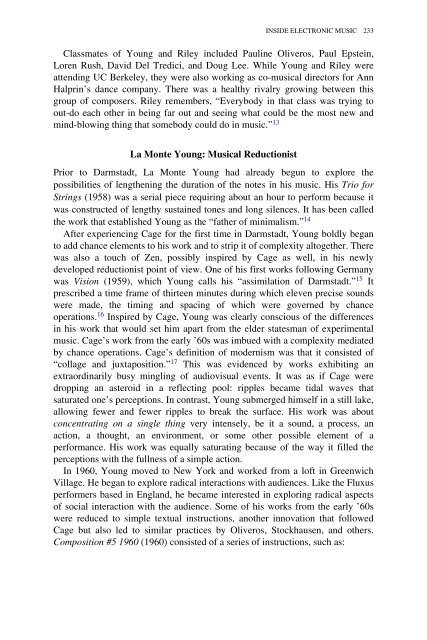Electronic and Experimental Music: Pioneers in ... - Aaaaarg
Electronic and Experimental Music: Pioneers in ... - Aaaaarg
Electronic and Experimental Music: Pioneers in ... - Aaaaarg
Create successful ePaper yourself
Turn your PDF publications into a flip-book with our unique Google optimized e-Paper software.
Classmates of Young <strong>and</strong> Riley <strong>in</strong>cluded Paul<strong>in</strong>e Oliveros, Paul Epste<strong>in</strong>,<br />
Loren Rush, David Del Tredici, <strong>and</strong> Doug Lee. While Young <strong>and</strong> Riley were<br />
attend<strong>in</strong>g UC Berkeley, they were also work<strong>in</strong>g as co-musical directors for Ann<br />
Halpr<strong>in</strong>’s dance company. There was a healthy rivalry grow<strong>in</strong>g between this<br />
group of composers. Riley remembers, “Everybody <strong>in</strong> that class was try<strong>in</strong>g to<br />
out-do each other <strong>in</strong> be<strong>in</strong>g far out <strong>and</strong> see<strong>in</strong>g what could be the most new <strong>and</strong><br />
m<strong>in</strong>d-blow<strong>in</strong>g th<strong>in</strong>g that somebody could do <strong>in</strong> music.” 13<br />
La Monte Young: <strong>Music</strong>al Reductionist<br />
INSIDE ELECTRONIC MUSIC 233<br />
Prior to Darmstadt, La Monte Young had already begun to explore the<br />
possibilities of lengthen<strong>in</strong>g the duration of the notes <strong>in</strong> his music. His Trio for<br />
Str<strong>in</strong>gs (1958) was a serial piece requir<strong>in</strong>g about an hour to perform because it<br />
was constructed of lengthy susta<strong>in</strong>ed tones <strong>and</strong> long silences. It has been called<br />
the work that established Young as the “father of m<strong>in</strong>imalism.” 14<br />
After experienc<strong>in</strong>g Cage for the first time <strong>in</strong> Darmstadt, Young boldly began<br />
to add chance elements to his work <strong>and</strong> to strip it of complexity altogether. There<br />
was also a touch of Zen, possibly <strong>in</strong>spired by Cage as well, <strong>in</strong> his newly<br />
developed reductionist po<strong>in</strong>t of view. One of his first works follow<strong>in</strong>g Germany<br />
was Vision (1959), which Young calls his “assimilation of Darmstadt.” 15 It<br />
prescribed a time frame of thirteen m<strong>in</strong>utes dur<strong>in</strong>g which eleven precise sounds<br />
were made, the tim<strong>in</strong>g <strong>and</strong> spac<strong>in</strong>g of which were governed by chance<br />
operations. 16 Inspired by Cage, Young was clearly conscious of the differences<br />
<strong>in</strong> his work that would set him apart from the elder statesman of experimental<br />
music. Cage’s work from the early ’60s was imbued with a complexity mediated<br />
by chance operations. Cage’s def<strong>in</strong>ition of modernism was that it consisted of<br />
“collage <strong>and</strong> juxtaposition.” 17 This was evidenced by works exhibit<strong>in</strong>g an<br />
extraord<strong>in</strong>arily busy m<strong>in</strong>gl<strong>in</strong>g of audiovisual events. It was as if Cage were<br />
dropp<strong>in</strong>g an asteroid <strong>in</strong> a reflect<strong>in</strong>g pool: ripples became tidal waves that<br />
saturated one’s perceptions. In contrast, Young submerged himself <strong>in</strong> a still lake,<br />
allow<strong>in</strong>g fewer <strong>and</strong> fewer ripples to break the surface. His work was about<br />
concentrat<strong>in</strong>g on a s<strong>in</strong>gle th<strong>in</strong>g very <strong>in</strong>tensely, be it a sound, a process, an<br />
action, a thought, an environment, or some other possible element of a<br />
performance. His work was equally saturat<strong>in</strong>g because of the way it filled the<br />
perceptions with the fullness of a simple action.<br />
In 1960, Young moved to New York <strong>and</strong> worked from a loft <strong>in</strong> Greenwich<br />
Village. He began to explore radical <strong>in</strong>teractions with audiences. Like the Fluxus<br />
performers based <strong>in</strong> Engl<strong>and</strong>, he became <strong>in</strong>terested <strong>in</strong> explor<strong>in</strong>g radical aspects<br />
of social <strong>in</strong>teraction with the audience. Some of his works from the early ’60s<br />
were reduced to simple textual <strong>in</strong>structions, another <strong>in</strong>novation that followed<br />
Cage but also led to similar practices by Oliveros, Stockhausen, <strong>and</strong> others.<br />
Composition #5 1960 (1960) consisted of a series of <strong>in</strong>structions, such as:












